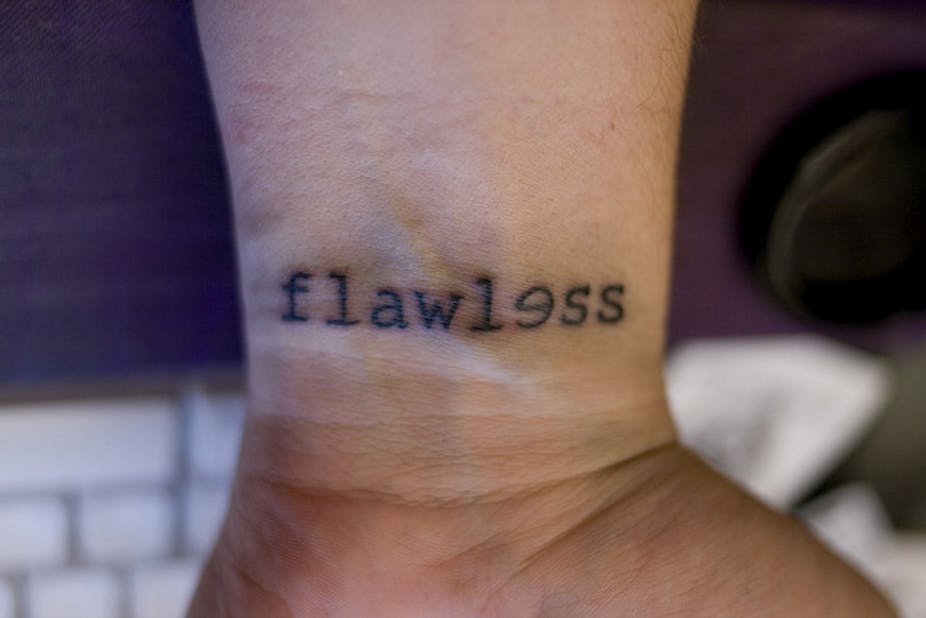Tattoo removal is a lucrative business. According to one estimate, about a quarter of Australians under 30 have a tattoo. And approximately a quarter of these people are planning to have it removed.
Tattoo removal remains unregulated, so it’s impossible to say how many clinics are currently operating in Australia. But look online and you’ll see an abundance of services advertised directly to consumers.
Treatment providers generally claim they offer high quality service “fast, safe, and painless”, performed by by experienced staff. Of course, these claims are difficult to verify. They tend to rely heavily on carefully crafted “frequently asked questions” or glowing testimonials from clients.
Read more about how tattoos are removed here.
Clinics advertise the most popular laser treatments from A$100 for the removal of a small (matchbox-sized) tattoo. Some also offer to remove tattoos by surgical excision and “dermabrasion”, which involves wearing away layers of skin with a wire brush or similar tool.
But treatments can involve a great deal more physical and financial pain that consumers are led to believe.
A word of warning
In a recent report, the consumer organisation Choice warned patients were at risk of suffering burns and scars from lasers used by unqualified and unskilled tattoo removers.
Choice indicated that some removers were using much cheaper versions of the “industry-standard Q-switch laser” — including the IPL lasers which are largely responsible for injury and unsuccessful tattoo removal.
Some companies offer assurances about their credentials using medical sounding names such as “certified laser practitioner”. But this often just indicates that training was undertaken by a laser maker, which may be a prerequisite for getting liability cover.
The relative ease of becoming a tattoo remover would seem to be one of the factors underpinning the growth of this industry. Virtually anyone can open up shop. And laser tattoo removal machines of varying price - and no doubt variable quality - can be readily purchased via ebay.

Some treatment providers have promoted tattoo removal as a market opportunity that involves few start-up costs and offers potentially significant profits. One company, Astanza, based in Houston, Texas, claims that “laser tatoo removal is going to be a huge business”. Its website notes,
Now is the ideal time to enter the laser tattoo removal industry. For the last decade, nothing has been hotter than tattoos. For the next decade, no cosmetic field will be more exciting than laser tattoo removal.
Astanza offers tattoo removal training programs and markets its laser machines and accessories throughout the world. It claims the costs and space required for setting up business is minimal and that removers can make an average of US$800 average revenue per hour or US$1,400 revenue per patient.
Surprise costs
Tattoo removal is part of a burgeoning body modification and enhancement industry that is difficult to regulate. Treatments available in Australia are advertised on international websites and can thereby bypass regulation of the Therapeutic Goods Administration.
As Choice notes, the costs of treatments may be more expensive than consumers are led to believe. This is because the costs depend on the thickness of the lines and the colour of the tattoo – green is especially difficult to remove.
Further, the removal of tattoos is likely to entail multiple treatments. According to Choice, “47% of tattoos require up to ten sessions to successfully remove with a Q-switched laser”. The removal of a multi-coloured tattoo may cost up to A$20,000.
While this industry is difficult to regulate, this doesn’t mean that it should not or cannot be regulated.
A typical policy response to the advertising of clinically unproven and potentially dangerous treatments has been to offer advice to those contemplating treatments. So-called stem cell tourism is a case in point. The International Society of Stem Cell Research offers web-based information for prospective patients, which includes patient guidelines on what to ask treatment providers.

Why get a tattoo, only to have it removed?
While a regulatory approach focused on informing consumers has some value, it fails to address the factors that underpin the strong appeal of tattooing that lead individuals to modify their bodies.
While tattooing has a long history in many cultures, in recent years tattoos have become popular among a broad section of the population. The practice of tattooing reflects the individualistic and consumerist ethos of our neoliberal times.
The consumption of treatments, likewise, provides an occasion for expressing agency and identity. New medical technologies, especially cosmetic technologies, are marketed on the basis of their potential to “enhance choice”.
We need a more sociologically informed approach to the regulation of the tattoo removal treatment industry which interrogates the hopes and promises that attach to the practices of body modification and enhancement. This includes strategies, such as school-based programs, oriented to challenging the strong emphasis on body image and bodily perfection.
Such an approach demands a critical appreciation of the complexities and vicissitudes of “choice” in the capitalist “free market”. This market offers the illusion that we are free to choose and change our identities through the purchase of certain body modification or enhancement treatments. It masks the reality that the options are already prescribed and our choices constrained.
This helps explain the logic of paying for a tattoo and then paying again to have it removed.

